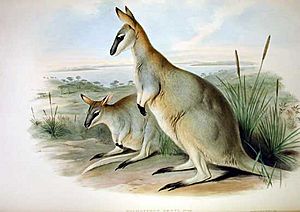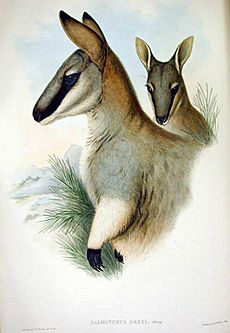Toolache wallaby facts for kids
Quick facts for kids Toolache wallaby |
|
|---|---|
 |
|
| Nineteenth century illustration of male and female | |
| Conservation status | |
| Scientific classification | |
| Genus: |
Macropus
|
| Species: |
greyi
|
The toolache wallaby (Macropus greyi), also known as Grey's wallaby, was a type of wallaby that lived in southeastern South Australia and southwestern Victoria. Sadly, this animal is now extinct.
Contents
What Was the Toolache Wallaby?
The toolache wallaby was first described by George Robert Waterhouse in 1846. The first specimen, which is a sample used for study, was found in Coorong in South Australia.
The name greyi and the common name Grey's wallaby honor George Grey. He was an explorer who collected two specimens for researchers at the British Museum of Natural History. Scientists later found that the toolache wallaby's closest relative was the western brush wallaby.
People also called this wallaby the monkeyface or onetwo.
What Did It Look Like?
The toolache wallaby was a slender and elegant animal. Its fur was a pale, ash-brown color on its back. Its belly was a buff-yellow.
Its tail was light grey and became almost white at the tip. A clear black mark stretched from its nose to its eye. Its front legs, feet, and ear tips were also black. The fur's color and texture might have changed with the seasons. They could also vary between different wallabies.
Male and female toolache wallabies had different body sizes. Males typically had a head and body length of up to 810 millimeters (about 32 inches). Females were slightly taller, measuring up to 840 millimeters (about 33 inches). However, males had longer tails, around 730 millimeters (about 29 inches). Female tails were about 710 millimeters (about 28 inches).
How Did It Live?
The toolache wallaby was a nocturnal animal. This means it was active at night. It would search for plants to eat during the early evening hours.
These wallabies moved in a very unusual and fast way. They could outrun almost any animal that hunted on land. They were even known to escape the fastest dogs used by hunters.
Where Did It Live?
The toolache wallaby lived in the southeastern part of Australia. Its habitat stretched into the western part of Victoria. They preferred areas with swampy, short grasslands. They also lived in taller grass areas of open country.
Toolache wallabies were social animals. They often lived in groups. People frequently saw them resting and eating together in these groups.
Why Did It Disappear?
Many things caused the toolache wallaby to decline and eventually become extinct. One major reason was the destruction of its habitat. Swamps were an important part of their home. When these swamps were cleared, much of the plants they ate disappeared too.
New predators, like the European red fox, were brought to Australia. These foxes also started to hunt and kill the wallabies. On top of this, people hunted the toolache wallaby for sport. They also hunted it for its beautiful fur.
When Did It Go Extinct?
The toolache wallaby only survived for about 85 years after Europeans settled in Australia. In the 1920s, people tried to save the animal. The plan was to catch the last few wallabies and breed them in zoos or special centers.
However, this effort ended badly. Out of 14 wallabies, 10 were accidentally killed during the attempt to capture them. The remaining four survived in captivity.
The last time a toolache wallaby was seen in the wild was in 1924. The last known toolache wallaby living in captivity died in 1939. The species is now believed to be extinct. Even though there were reports of possible sightings in the 1970s, no toolache wallabies have been seen since then.
See also
 In Spanish: Ualabí de Grey para niños
In Spanish: Ualabí de Grey para niños



